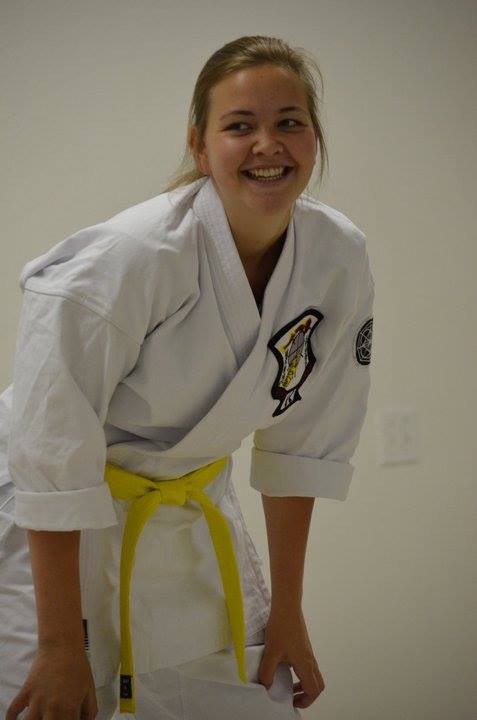





AGES 15 AND UP Kenpo Adults
GV Kenpo Family Karate’s adult program is self defense instruction for ages 15 years and up. Kenpo Karate is a stand-up striking art that uses multiple strikes performed at a high rate of speed and power to overwhelm an attacker. Kenpo is designed to work for any age, body type, or gender. It works for everyone. You do not have to be big or strong to learn Kenpo. We will teach you how to understand your body in order to hit with proper mechanics and to move with precision and purpose. Kenpo Karate is a comprehensive system designed to counter real attacks. While it is a traditional martial art, it also takes a logical, scientific, and practical approach to self defense and training. Our art works as well in the dojo as it does on the street. When you learn Kenpo, you will gain confidence through challenging yourself.
Here are some of the skills you can expect to learn in the Kenpo Adult Program:
- Confidence
- Coordination
- Discipline
- Increased self esteem
- Physical exercise and health
- Environmental awareness
- Positive mental attitude
- Perseverance
- Control
- Muscle memory
THE PROCESS:
We start with two classes each week, 60 minutes each. Kenpo Adults can attend any extra classes that are on the schedule, such as open-mat or sparring. Students practice their skills in class (and at home!) and can earn new rank belts with a test.
CLASS FORMAT:
Each class starts with a warm-up, followed by either skill-building drills, review, or new Kenpo material. We finish with stretching.
REQUIREMENTS FOR ADVANCEMENT:
There are eight belt color levels in the Kenpo Adults program (with 3 levels of brown belt): white, yellow, orange, purple, blue, green, brown, and black belt. At GV Kenpo Family Karate, black belts are only awarded to adults. At each belt level test, the student must demonstrate the required skills of their next rank. Kenpo Adults will be eligible to test for their rank after the instructor is confident that they have learned all of the required material. We will not test a student that we feel is not ready. Our job is to make our students successful.
KENPO SKILLS:
- Basics (single moves)
- Self defense techniques on an attacker
- Empty hand forms (katas)
- Sets
- Controlled Sparring
- Questions and answers
Basics: Kenpo basics are defined as “one single move”. They consist of blocks, strikes, punches, stances, foot maneuvers, kicks, and finger techniques. They make up the foundation of our system.
Techniques: Techniques are defined as “a combination of three or more basics for a given or specified situation, i.e. attack.” The system of Kenpo Karate is built upon a foundation of techniques. These are defensive responses to different realistic attacks ranging from punches and kicks to locks and chokes. Each belt level has sixteen unique techniques except yellow belt, which has ten. Techniques can be practiced on your own, or with a partner.
Forms: Each belt level has its own forms, or kata. Each form is a continuous and flowing series of basics and techniques that synchronize the upper and lower body to work together as a unit. They are made to simulate attack by multiple opponents. Forms are designed to be practiced on your own. They promote proper use of stances and angles to teach rules and principles of motion. The forms increase in complexity as the student advances.
Sets: Kenpo Karate makes use of sets as a training tool as well. Sets focus on individual, specific aspects of the art, such as blocking, striking and kicking.
Sparring: On the most basic, we teach sparring and sparring drills for one particular purpose: to help the students learn and understand the fundamental movements as well as the application of kicking and punching combinations. When the student learns self defense techniques, they learn the ideal phase first, where everything works according to plan. Then, the student starts to learn “what ifs”. What if the attacker does something you don’t expect, and how do you react to that. Sparring is considered to be spontaneous. You learn to react on the fly, defending as well as attacking. Kenpo Karate cannot be a complete system without incorporating sparring. We spar safely in the dojo, wearing full protection head-to-toe. The student also learns to control themselves, making sparring an all around enjoyable experience.
Questions and answers: “If it has a name, it has a definition.” This is a quote from our instructor, Senior Master of the Arts Richard ‘Huk’ Planas. We never teach “meaningless motion”. Instructors as well as students should be able to explain everything that we do. And when students test, it won’t only be physical. While you must perform the techniques, basics, and forms, you also must be able to describe the hows and whys of what you are doing.
